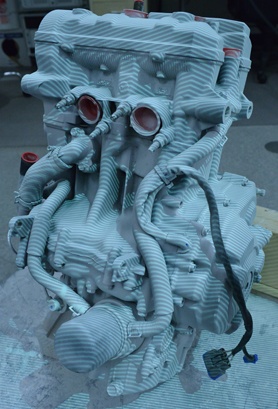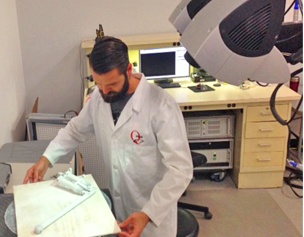
California State University, Fullerton's Formula SAE chapter is back from their brief break to build another beast of a race car. Using Q-PLUS Labs' 3D scanning expertise to aid them, the team enters into their 3rd year in the challenging Formula SAE competition which encompasses designing, building, and competing a mini-formula style race car that will be evaluated for its potential as a production item.
Introduction
 This year, California State University, Fullerton's Formula SAE is using a Yamaha FZ-07 motorcycle engine which has increased displacement for their new race car design. The new design for the chassis will include a space frame as well as a carbon fiber driver cell. The space frame is created by welding steel tubes together and attaching them to the cockpit and the engine housing, as well as the drive train. Unlike the team's last design which was a stressed engine, this design will be mounted to the inside of the space frame. Weighing 20 to 30 pounds less than the team's original engine, this choice also offers more torque and faster acceleration without creating a heavier car which would give the team an edge against their competition.
This year, California State University, Fullerton's Formula SAE is using a Yamaha FZ-07 motorcycle engine which has increased displacement for their new race car design. The new design for the chassis will include a space frame as well as a carbon fiber driver cell. The space frame is created by welding steel tubes together and attaching them to the cockpit and the engine housing, as well as the drive train. Unlike the team's last design which was a stressed engine, this design will be mounted to the inside of the space frame. Weighing 20 to 30 pounds less than the team's original engine, this choice also offers more torque and faster acceleration without creating a heavier car which would give the team an edge against their competition.
Our Process
Because the final race car's design needs to be both fast and safe and relies on the integrity of the engine's measurements, Cal State Fullerton's SAE sought the expertise of Q-PLUS Labs' dimensional measurement engineers. Using the Steinbichler Comet 5, Q-PLUS Labs was able to provide CSUF's SAE team with accurate measurements of the engine to provide the structure for the race car's design. Using these points from the scan data, the team can proceed to confidently to create a CAD model of the car designed with both the driver's safety and structural integrity in mind. Follow CSUF's Formula SAE's journey and results here in our future blog post.





 A little background on the rigorous Baja SAE race—it originated in 1976 at the University of South Carolina as a comprehensive engineering competition with the objective for students to function as a team and not only design, build, test, promote, and race a vehicle, but also raise financial support while balancing the demands of their course work. In order to compete as formidable opponent at the 2016 Baja SAE race, the final single-seat, all-terrain sporting vehicle is comprised of parts machined by CSUF’s Baja team.
A little background on the rigorous Baja SAE race—it originated in 1976 at the University of South Carolina as a comprehensive engineering competition with the objective for students to function as a team and not only design, build, test, promote, and race a vehicle, but also raise financial support while balancing the demands of their course work. In order to compete as formidable opponent at the 2016 Baja SAE race, the final single-seat, all-terrain sporting vehicle is comprised of parts machined by CSUF’s Baja team. cle’s ability to successfully navigate the race due to the challenging track. CSUF’s Baja team requested Q-PLUS Labs to 3D scan the cutting brake that provided the team with measurement data from which they can derive the best fit area of the car to mount the brake. Using the
cle’s ability to successfully navigate the race due to the challenging track. CSUF’s Baja team requested Q-PLUS Labs to 3D scan the cutting brake that provided the team with measurement data from which they can derive the best fit area of the car to mount the brake. Using the 
